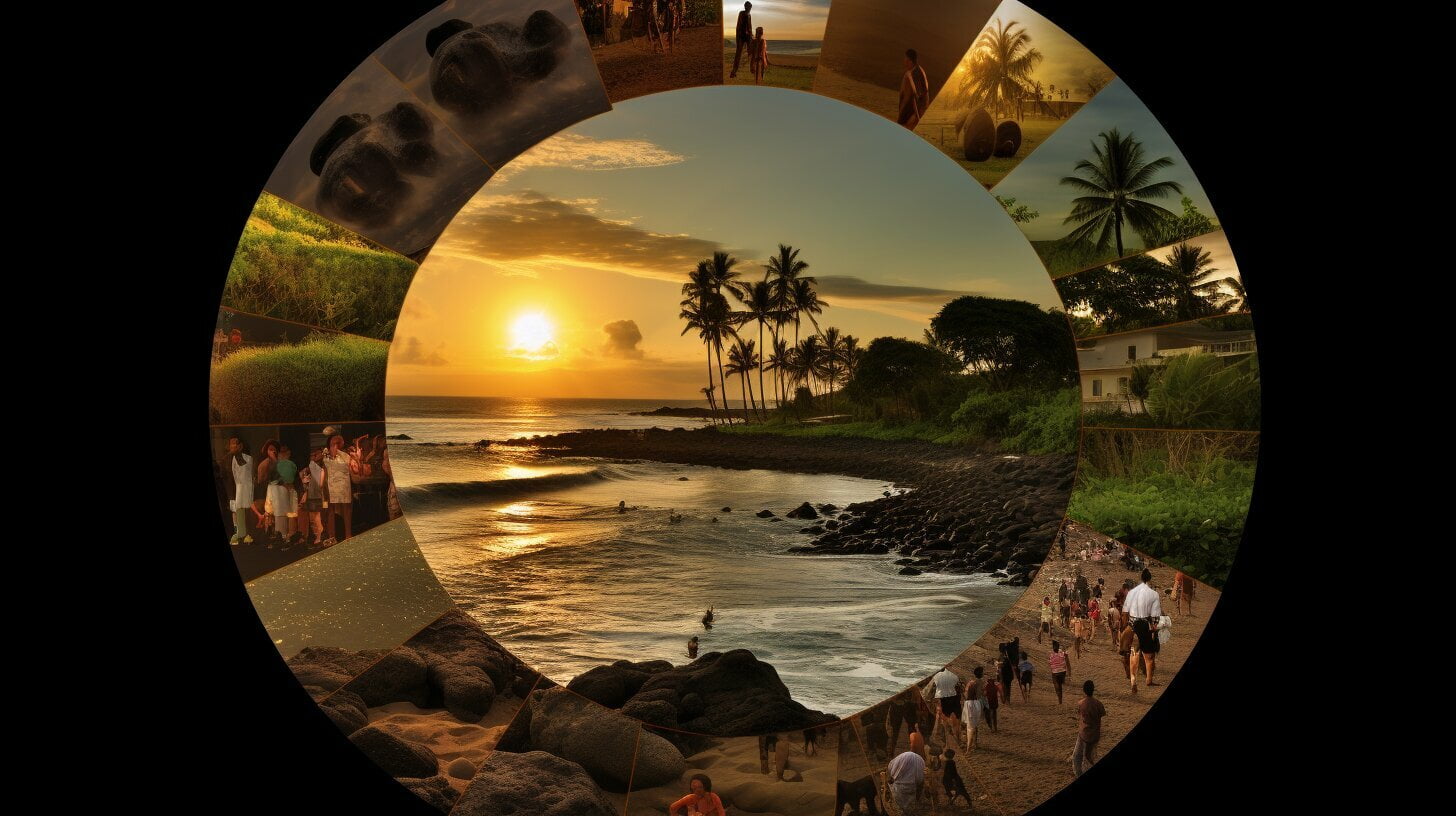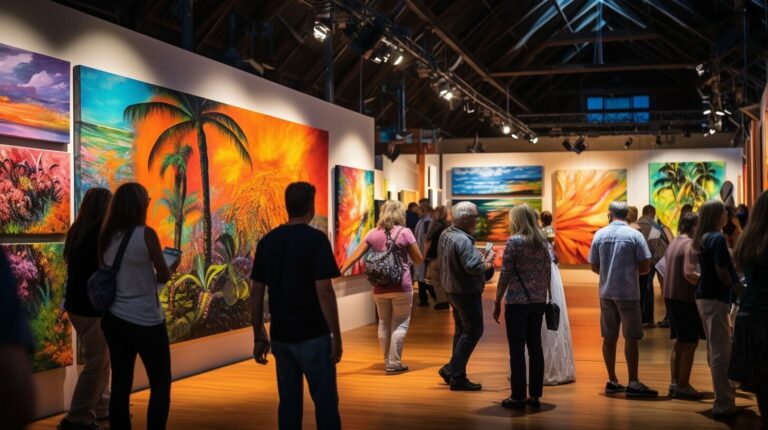Unraveling the Linguistic Tapestry of the Big Island 🌺
The Big Island of Hawaii is known for its breathtaking scenery and rich cultural heritage. One aspect of this heritage that often goes overlooked is the island’s linguistic diversity. With over ten different languages spoken on the island, language plays a critical role in shaping local customs and traditions.
From Native Hawaiian to Japanese and Spanish, each language on the Big Island carries its unique cultural significance. Understanding this diversity is essential in comprehending the island’s culture and communication style.
Key Takeaways
- The Big Island of Hawaii is home to over ten different languages
- Understanding language diversity is crucial to understand the island’s culture
- Each language on the Big Island carries unique cultural significance
The Linguistic Heritage of the Big Island
The Big Island is a melting pot of different cultures and languages, which has shaped its unique linguistic heritage. From the native languages of Hawaiian and Pidgin to the influences of Portuguese, Japanese, and Filipino languages, the Big Island has a rich history of linguistic diversity.
The Hawaiian language, also known as ʻŌlelo Hawai’i, is the official language of the state of Hawaii and holds a special place in the hearts of locals. However, the language was widely suppressed from the late 19th century to the mid-20th century, resulting in a loss of fluency among the general population.
Today, there is a renewed drive to promote and preserve the Hawaiian language, with various language programs available on the Big Island. One such program is the Hawaiian Language Immersion Program (HLIP), which provides Hawaiian-medium education to children from pre-kindergarten through high school.
| Language Learning Opportunities | Description |
|---|---|
| Language Classes | Several language schools on the Big Island offer classes in Hawaiian, Japanese, and more. |
| Language Immersion Programs | The HLIP provides Hawaiian-medium education to children from pre-kindergarten through high school. |
| Language Study Programs | The University of Hawaii at Hilo offers various language study programs for Hawaiian, Japanese, and other languages. |
The Importance of Language Learning
Learning a new language not only helps individuals better understand and appreciate different cultures, but it can also lead to improved communication and job opportunities. In a globalized world, language skills are becoming increasingly valuable, making language learning programs on the Big Island more relevant than ever.

Whether it’s through private language classes, language immersion programs, or advanced language study programs at the University of Hawaii, the Big Island offers a diverse range of opportunities for individuals looking to learn a new language or improve their existing language skills.
Communication Styles on the Big Island
Effective communication on the Big Island requires understanding and respect for the cultural nuances and unique communication styles present in the local community. Hawaiians value direct and respectful communication that emphasizes harmony and inclusivity. They also place a strong emphasis on nonverbal communication, such as body language and tone of voice.
Additionally, there are various Pidgin English dialects spoken on the Big Island, which have their own distinct grammar, vocabulary, and pronunciation. These dialects reflect the island’s diverse cultural influences and history.

Image source: seowriting.ai/32_6.png
Language Learning Opportunities on the Big Island
For visitors looking to expand their language skills while experiencing the local culture, the Big Island offers a variety of language learning opportunities. From formal classes to immersive programs, language education on the Big Island caters to all interests and proficiency levels.
For those interested in learning Hawaiian, several language schools and programs offer language courses for beginners and advanced learners alike. The University of Hawaii at Hilo’s Ka Haka ʻUla O Keʻelikōlani College of Hawaiian Language, for example, provides a range of language courses and immersion experiences that promote the use and preservation of the Hawaiian language and culture. Students can take introductory courses in Hawaiian language and culture, or immerse themselves in advanced language courses and community-based learning programs.
For visitors interested in learning other languages, programs like the Pacific Intercultural Exchange offer language immersion experiences that focus on Japanese and Chinese culture and language. These programs provide a unique opportunity to learn the language in a real-life context, practicing language skills with native speakers and experiencing the culture firsthand.
Language Study Programs
For those looking to study a language more intensively, language study programs are available on the Big Island. Universities such as the University of Hawaii at Hilo and Hawaii Community College offer courses in languages such as Spanish, Japanese, and Mandarin Chinese. These programs provide an opportunity for students to earn academic credit while learning about the culture and language of the Big Island.
Language Immersion Programs
For a more immersive language learning experience, visitors can enroll in language immersion programs that offer total language and cultural immersion. These programs provide an opportunity to live with host families and participate in community events while learning the language. The Center for World Languages and Cultures at Hawaii Community College, for example, offers a Japanese language immersion program that includes homestay accommodations and cultural activities such as tea ceremonies and calligraphy workshops.

Language learning opportunities on the Big Island provide a unique way to engage with the island’s culture and communities. Whether you’re interested in learning Hawaiian or another language, there are a variety of programs and courses available to suit your interests and needs. By learning a language on the Big Island, you’ll not only expand your language skills but also gain a deeper appreciation for the island’s culture and history.
Preserving Language and Cultural Heritage
The Big Island of Hawaii is home to a rich linguistic heritage, with several indigenous languages that are endangered due to the onslaught of globalization and the dominance of English. In recent years, efforts have been made to preserve these languages and promote the cultural heritage of the island.
One of the primary organizations working towards this goal is the Pacific American Foundation, which has been actively involved in language revitalization programs and education. The organization has created language classes in various indigenous languages, including Hawaiian and Tahitian, and is working towards creating immersion experiences for language learners.
The University of Hawaii at Hilo is another institution that is contributing to the preservation of language and cultural heritage on the Big Island. The university’s Ka Haka ‘Ula O Ke’elikolani College of Hawaiian Language offers language courses in Hawaiian, as well as a Hawaiian immersion program that allows students to become fluent in the language.
Additionally, various community-led initiatives have emerged to promote language and cultural heritage on the Big Island. The ‘Olelo Hawai’i Community-Based Language Program is one such initiative, which seeks to create opportunities for community members to learn Hawaiian. The program is offered free of charge and is taught by fluent speakers of the language.
Efforts to preserve language and cultural heritage on the Big Island are crucial in maintaining the unique identity of the island’s communities. By promoting and preserving indigenous languages, cultural practices, and traditions, the island can continue to thrive as a diverse and culturally rich destination.

Language as a Bridge between Cultures
The Big Island of Hawaii is home to a diverse range of cultures and languages, each with its unique customs, traditions, and ways of communicating. However, language serves as a powerful tool to bridge the gap between these cultures, facilitating cross-cultural understanding and unity.
By learning and speaking the languages of other cultures on the island, individuals can break down communication barriers and gain a deeper appreciation for the customs and traditions of others. Language also serves as a window into the history and heritage of a culture, providing insight into the beliefs, values, and customs that underpin its way of life.
When individuals take the time to learn and speak another’s language, it demonstrates a genuine interest in and respect for their culture. This fosters a sense of openness and mutual respect, promoting positive interactions and reducing misunderstandings.
Moreover, language has the power to bring people together and create a sense of community, particularly within minority language groups. For example, the Hawaiian language has gained new life in recent years through community-led initiatives aimed at revitalizing and promoting its use.

As communities come together to celebrate their language and culture, they create a sense of belonging and pride, fostering a deeper appreciation for the unique linguistic heritage of the Big Island.
The Power of Language Education
Language education plays a critical role in promoting cross-cultural understanding and unity on the Big Island. Through language classes, immersion programs, and study abroad opportunities, individuals can gain a deeper understanding of different cultures and gain valuable communication skills.
Language programs on the Big Island range from formal classroom settings to more informal immersion experiences, catering to a wide range of learning styles and preferences. Organizations such as the University of Hawaii at Hilo and the Hawaii Department of Education offer programs in various languages, including Hawaiian, Japanese, and Spanish.
Additionally, several non-profit organizations and community-led initiatives are working to preserve and promote the indigenous languages of the Big Island. These efforts serve as a crucial means of maintaining the linguistic heritage of the island and fostering a deep appreciation for its cultural diversity.
Ultimately, language serves as a vital tool for connecting individuals and promoting unity on the Big Island. By fostering cross-cultural understanding and celebrating linguistic diversity, locals and visitors alike can gain a deeper appreciation for the unique cultural fabric of the island.
Community Initiatives for Language Revitalization
Given the linguistic diversity of the Big Island and the cultural significance of indigenous languages, many community-led initiatives have emerged to preserve and promote endangered languages. These initiatives range from language classes and immersion programs to grassroots efforts to document and record the oral histories and narratives of native speakers.
One notable example is the ‘Aha Punana Leo, a non-profit organization founded in 1983, which aims to revitalize the Hawaiian language and pass it on to future generations. Through its language immersion schools and community-based programs, ‘Aha Punana Leo has played a crucial role in the Hawaiian language renaissance, with the number of fluent Hawaiian speakers increasing from only a few hundred in the 1980s to over 2,000 today.
Another initiative is the Hale Kuamo’o Hawaiian Language Center, which offers language courses, teacher training, and research facilities to promote the preservation and revitalization of the Hawaiian language. The center also works with local schools and organizations to provide language resources and support to language learners and educators.
Other community-led initiatives include the documentation and preservation of endangered languages through oral history projects such as the ‘Olelo Project by the Papakilo Database, which records and archives interviews with native speakers of Hawaiian and other Polynesian languages. Similarly, the Na Pua No’eau Center for Gifted and Talented Native Hawaiian Children at the University of Hawaii Hilo offers a range of programs and resources for Hawaiian language learners and educators, as well as cultural preservation activities for the wider community.
These community initiatives reflect the growing awareness of the importance of language in preserving cultural identity and heritage. By working together to revitalize endangered languages, these initiatives are helping to build a stronger and more diverse community on the Big Island.
Conclusion
Language has always been an integral part of the cultural fabric of the Big Island, and its diversity mirrors the rich and complex history of its people. From its indigenous languages to the languages brought by its various immigrant communities, the Big Island has a linguistic heritage unlike any other place in the world.
Today, language continues to play a crucial role in the island’s communication styles and cultural interactions. Various language learning opportunities are available for those who wish to immerse themselves in the local language and culture.
Efforts are also being made to preserve and promote the indigenous languages and cultural heritage of the Big Island. Community-led initiatives are leading the way, showcasing the importance of community involvement in language revitalization.
Language as a Bridge Between Cultures
Language has the power to bring people together, to break down barriers and foster understanding between different cultures. On the Big Island, language is not just a means of communication, but also a bridge between diverse communities.
Through language, we can learn about and appreciate the unique perspectives and traditions of others. By embracing linguistic diversity and promoting language education, we can create a more inclusive and culturally rich society.
As we move forward, we must continue to recognize and celebrate the importance of language in the cultural heritage of the Big Island. By doing so, we can ensure that the linguistic diversity of this island will not only be preserved but also celebrated for generations to come.







